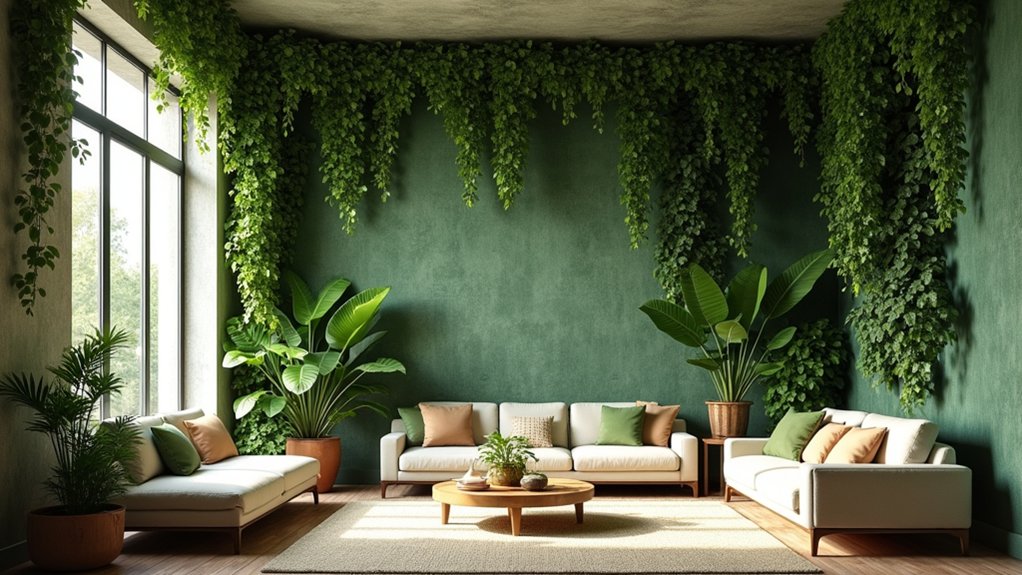
18 Green Walls Living Room Ideas That Bring Nature Indoors
Green walls in living rooms blend biophilic design and modern style, using vertical gardens, luxuriant accent hues, and organic materials to create vibrant sanctuaries. Lush botanical walls, statement plant shelves, and natural wood pairings add textural depth. Botanical wallpapers, climbing plants, and double-drenching techniques introduce dimensionality and tranquility. Incorporating artwork, modular plant displays, and tropical murals further enhances sophistication. Exploring these curated concepts reveals how green walls can enhance interiors with serene energy and contemporary flair.
Key Takeaways
- Install a vertical garden or living wall with climbing plants like pothos and philodendron for a dynamic, air-purifying focal point.
- Paint an accent wall in deep or pastel green to create a sophisticated, calming backdrop that connects the living room to nature.
- Combine green walls with natural wood elements or textured panels for warmth, visual depth, and a biophilic design effect.
- Layer green accessories and artwork on or near green walls to enhance dimension, unify the color scheme, and maximize natural light vibrancy.
- Use innovative techniques like double-drenching green on walls and ceilings, or add leafy murals and tropical motifs for a lush, immersive atmosphere.
Vertical Gardens as Living Art
While contemporary interior design continually evolves, vertical gardens—also known as living walls—have emerged as a sophisticated fusion of art and biophilic design.
These installations transform flat surfaces into dynamic botanical canvases, seamlessly blending organic textures with architectural precision. By thoughtfully integrating diverse plant species, vertical gardens do more than provide visual intrigue; they actively enhance indoor air quality by filtering airborne pollutants and increasing oxygen levels. Incorporating plants such as the Anthurium Clarinervium and Alocasia Zebrina can enhance aesthetics and improve humidity, thus benefitting skin and respiratory health.
Vertical gardens enliven interiors, merging lush plant life with design while purifying air and elevating the living environment.
Their innate ability to deliver thermal insulation supports ambient temperature regulation, contributing to energy efficiency within the living room. Customizable for varying light conditions and maintenance preferences, these living walls offer both functional and aesthetic versatility.
Beyond their physical benefits, exposure to lush greenery within the home has been shown to support mental well-being and reduce stress, elevating residential interiors holistically.
Lush Green Accent Walls
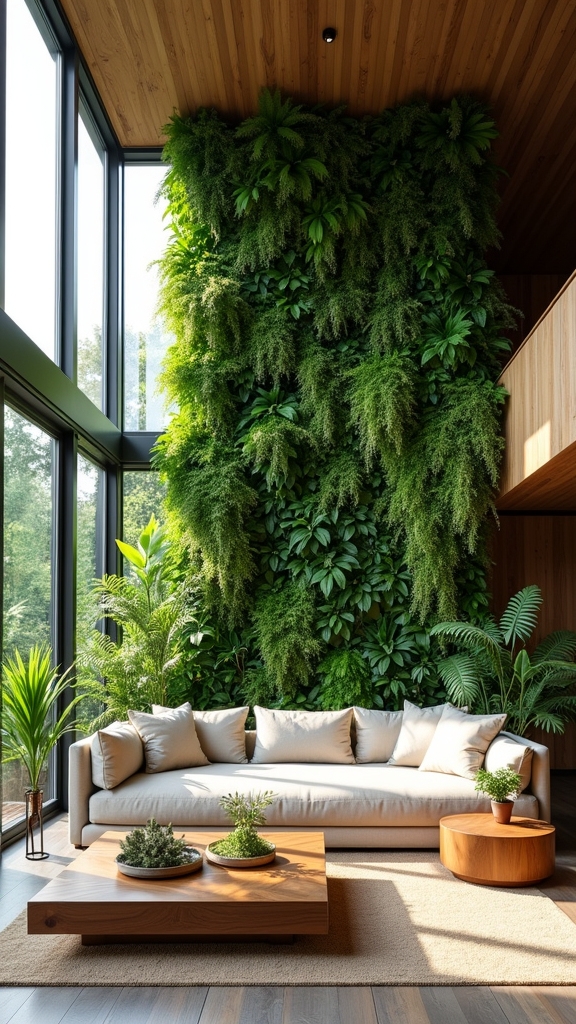
Expanding upon the concept of nature-inspired interiors, lush green accent walls offer a striking alternative to living plant installations, delivering immediate visual impact through rich, saturated hues.
Deep green tones, such as emerald and forest, introduce sophistication and depth, transforming the living room into a cozy, inviting retreat. By establishing a bold focal point, these walls enhance the ambiance while maintaining a harmonious balance when paired with lighter furnishings and decor.
Strategic use of textured finishes or subtle patterns further enhances visual intrigue, lending dimension and tactile interest to the green accent wall. Introducing plush textiles like linen or silk can add depth and comfort to the room.
This approach allows for a refined interplay of color and surface, underscoring current trends that favor biophilic aesthetics and immersive, earthy palettes.
The result is a contemporary, visually compelling living space.
Pairing Green Walls With Natural Wood
Blending verdant wall tones with natural wood surfaces introduces a sophisticated interplay of color and materiality, aligning with the contemporary trend of biophilic design.
This design approach leverages the harmonious relationship between green walls and natural wood, cultivating a warm, organic ambiance that echoes the tranquility of nature.
Light wood, such as blonde oak, pairs seamlessly with soft green hues for a fresh, airy impression, while darker timbers like walnut intensify the opulence of deep green palettes.
Textural contrast between smooth painted walls and tactile wood elements—beams, shelving, or floors—grounds the aesthetic and enhances spatial cohesion.
- Select complementary wood tones for green wall shades.
- Layer wooden accent pieces for visual equilibrium.
- Emphasize natural textures for sensory richness.
- Integrate wood flooring to anchor the overall scheme.
Incorporating Indoor Climbing Plants
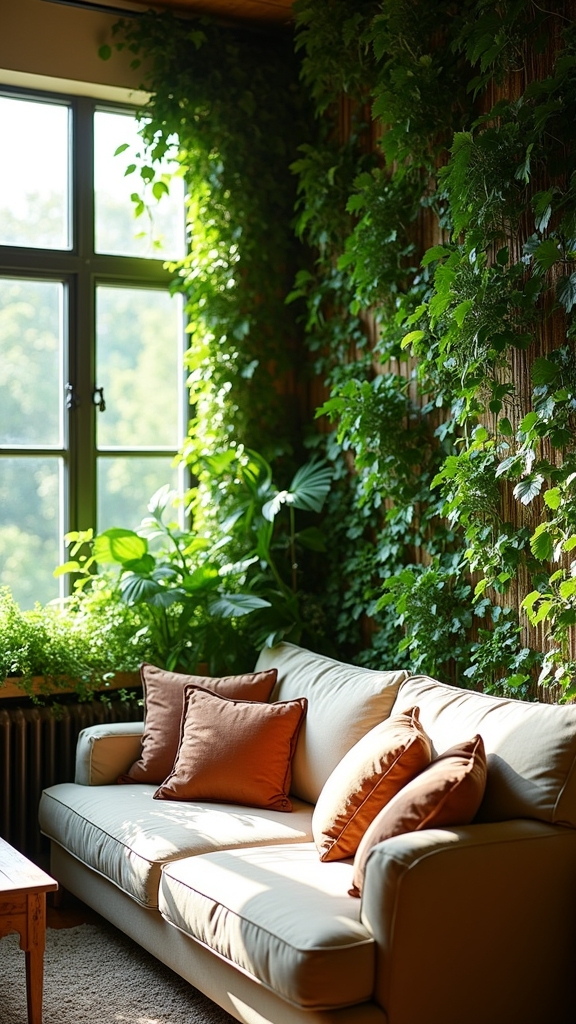
By integrating indoor climbing plants into a living room with green walls, designers achieve a multidimensional interplay between architecture and nature.
Species such as pothos, ivy, and philodendrons are particularly favored for their adaptability to diverse light conditions and their ability to infuse spaces with verdant liveliness.
Pothos, ivy, and philodendrons thrive in various light, bringing adaptable greenery and vibrant energy into any indoor setting.
When trained along trellises, wall-mounted planters, or shelves, these indoor climbing plants accentuate verticality, generating layers of botanical texture and visual intrigue.
Pothos adapts to various light conditions, making it ideal for adding lush greenery to living rooms.
Beyond aesthetics, climbing plants enhance indoor air quality by filtering toxins, contributing to a healthier living environment.
Strategic plant selection and placement promote a lush, layered effect, complementing the tranquil ambiance established by green walls.
Consistent pruning and irrigation guarantee vigorous growth, allowing the living room to maintain its curated, biophilic appeal.
Botanical Wallpaper for a Nature-Inspired Space
Botanical wallpaper introduces biophilic design elements through intricate leaf patterns and verdant hues, instantly elevating the living room’s ambiance.
Selecting motifs in harmonious greens and earth tones creates visual depth, while pairing with organic textures such as rattan and natural wood reinforces an authentic, nature-inspired aesthetic.
Strategic integration with tactile materials guarantees a balanced and contemporary interpretation of indoor greenery.
Choosing Botanical Wallpaper Patterns
Wallpaper featuring botanical motifs serves as a dynamic tool in contemporary interior design, infusing living rooms with both visual interest and tranquility.
Botanical wallpaper, particularly in green shades, cultivates a biophilic ambiance that resonates with current wellness-focused trends. Designers often select from a spectrum of patterns, ranging from bold tropical foliage to delicate minty hues, to tailor the room’s mood and energy.
The interplay of leafy silhouettes and verdant tones not only enlivens the space but also supports a calming, restorative environment. For a cohesive look, attention to pattern scale, color saturation, and motif complexity is essential.
- Choose tropical prints for dramatic, statement-making vibrancy.
- Opt for muted green shades for subtle, serene atmospheres.
- Evaluate pattern scale to maintain visual harmony.
- Select motifs that complement existing furniture and décor.
Pairing With Natural Textures
Texture interplay defines the most sophisticated nature-inspired living rooms, where lush green botanical wallpaper acts as a visual anchor against organic surfaces like rattan, jute, or raw wood.
The integration of botanical wallpaper with natural textures introduces dimensional layering, amplifying the biophilic aesthetic. Matte-finish wallpapers minimize glare, allowing verdant motifs to stand out without overwhelming the senses, while the tactile contrast of woven fibers and exposed timber frames the botanical patterns with warmth and authenticity.
Thoughtful illumination—soft, diffused lighting—accentuates the vibrancy of both wallpaper and materials, fostering a tranquil ambiance.
For heightened cohesion, strategically placed houseplants extend the textural dialogue, echoing the natural forms depicted on the walls. This technical approach results in a harmonious, immersive environment that epitomizes contemporary indoor-outdoor synergy.
Layered Green Tones for Depth
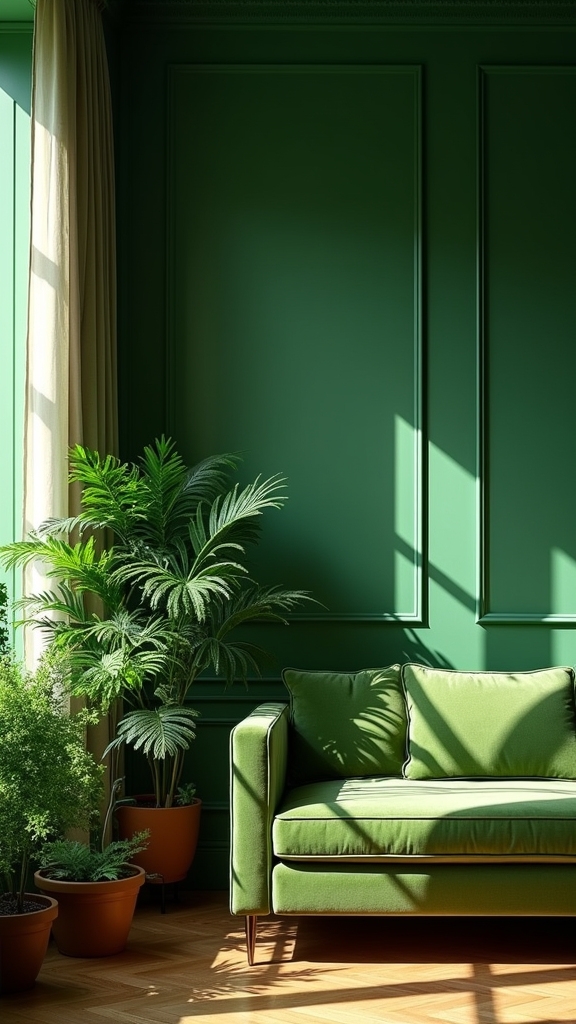
Layering various green tones, from muted sage to bold emerald, introduces a sophisticated sense of depth and dimension to the living room palette.
Accessories in contrasting hues and diverse textures—think velvet cushions or glass vases—act as visual punctuation, enhancing the monochromatic story.
To prevent oversaturation, integrating neutral elements such as pale wood or cream textiles guarantees balance and spatial harmony.
Mixing Light and Dark
When thoughtfully applied, the interplay of light and dark green tones introduces visual depth and sophistication to a living room’s palette.
Layering different shades of green—such as pairing soft mint walls with dark green paint on accent pieces—creates a contemporary yet timeless aesthetic. This nuanced approach heightens the perception of space and brings a tranquil, biophilic ambiance indoors.
The juxtaposition of light and dark greens, especially with textured materials, enhances visual intrigue and warmth.
- Contrast Effect: Dark green paint on furniture against pale green walls delivers striking visual contrast, making the space feel dynamic.
- Textural Variety: Incorporating plush rugs and knitted throws in various green hues amplifies tactile richness.
- Scenic Arrangement: Strategically placing plants of varying heights and greens reinforces the layered effect.
- Serene Atmosphere: Mixing light and dark greens evokes calm, channeling nature’s tranquility.
Accentuating With Accessories
Building upon the interplay of green wall tones, accessories become instrumental in amplifying spatial depth and visual interest.
Thoughtful layering of green accessories—plush cushions in sage, knitted throws in forest green, or glass vases in olive—establishes a nuanced chromatic dialogue with the backdrop.
Integrating varied textures intensifies this effect, offering tactile contrast that enlivens the living room’s atmosphere.
Patterned elements, such as geometric or botanical motifs in diverse green tones, inject dynamic energy and a hint of playfulness, preventing visual monotony.
Living greenery, whether trailing ivy or sculptural succulents, acts as both accent and continuation of the room’s organic palette.
Curated artwork featuring gradients or splashes of green hues further unifies the scheme, reinforcing depth and forging a harmonious, immersive environment.
Balancing With Neutrals
While green walls command attention through their chromatic vibrancy, nuanced depth emerges by interweaving layered green tones with neutral elements.
This balancing with neutrals approach guarantees the living room remains visually sophisticated rather than overwhelming. Pairing deep emerald upholstery with soft sage wall paint, for example, creates dimensionality and subtle contrast.
Neutral accents such as beige throws or light-toned wood furniture act as visual breathers, grounding the intensity of green tones. Textural diversity—think plush green rugs and knitted throws—adds tactile richness and warmth.
Botanicals in varied heights infuse biophilic energy while echoing the color palette for seamless cohesion.
- Combine bold and muted green tones for dynamic layering.
- Incorporate neutral elements to ground the palette.
- Use tactile materials for added sensory interest.
- Strategically place plants to enhance cohesion.
Statement Green Wall Panels
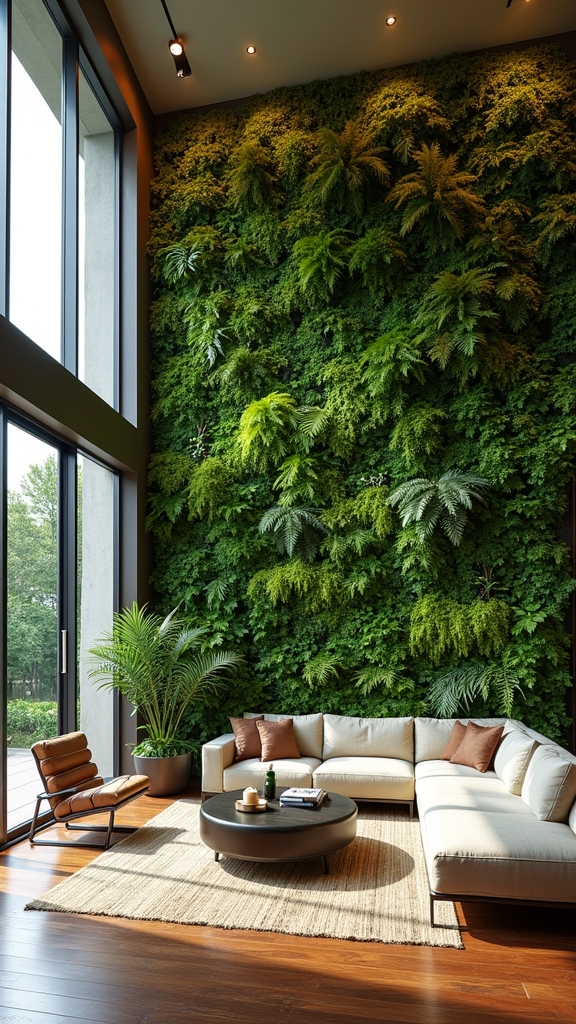
Elevating contemporary interiors, statement green wall panels introduce tactile depth and a biophilic focal point that draws the outdoors in.
These panels, rendered in nuanced greens such as sage and forest, transform living rooms by layering texture and amplifying visual intrigue. Statement green wall panels serve as a sophisticated backdrop for curated artwork or sculptural decor, achieving cohesion between organic and modern elements.
Green makes a room both visually soothing and architecturally dynamic, especially when juxtaposed with light-toned furnishings or metallic accents—resulting in a compelling interplay of hues and finishes.
Beyond aesthetics, integrating greenery through wall panels can subtly purify indoor air and foster a calming ambiance, reinforcing the connection to nature that defines the latest in interior design trends. Incorporating natural elements such as wood, stone, and plants enhances the calmness and aesthetic appeal of living spaces.
Mixing Green Walls With Patterned Decor
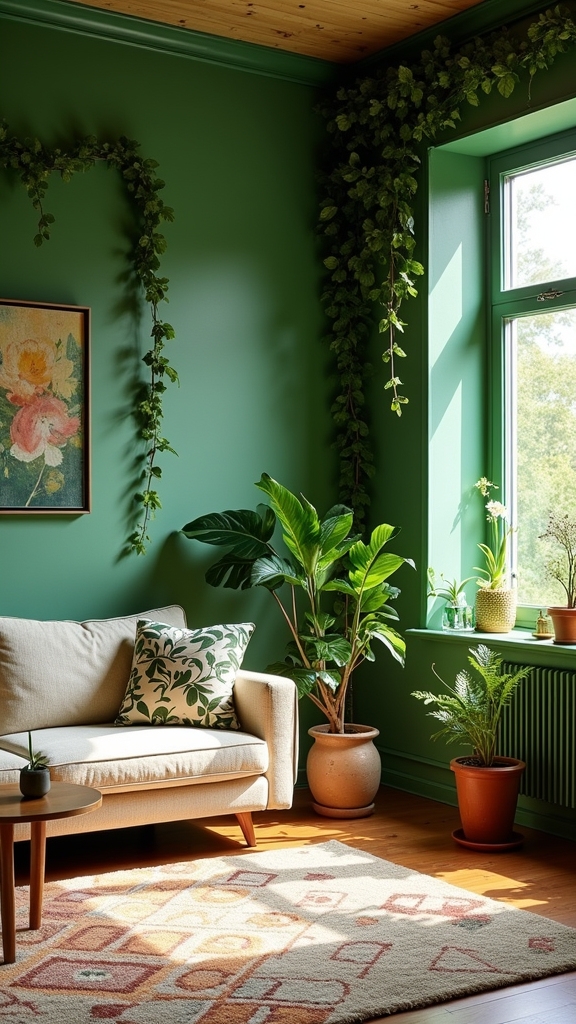
How can contemporary interiors achieve both vibrancy and cohesion? The interplay between green walls and patterned decor is a sophisticated approach to enliven living spaces without sacrificing harmony.
By integrating bold patterns—such as botanicals or geometric motifs—in textiles and accessories, designers accentuate the organic appeal of green walls while maintaining a curated palette. Layering in patterned decor introduces tactile dimension and visual dynamism, yet scale awareness guarantees the room remains balanced rather than chaotic.
Bold patterns in textiles amplify green walls’ freshness, while careful layering and scale ensure interiors feel dynamic yet harmonious.
- Select patterns that echo the green tones of the walls for seamless color integration.
- Use patterned textiles—think cushions, rugs, or curtains—to soften the visual impact and add depth.
- Mix large and small-scale prints for tailored contrast and interest.
- Anchor the look with neutral or complementary furnishings for a cohesive, inviting ambiance.
Green Walls and Light, Airy Furnishings
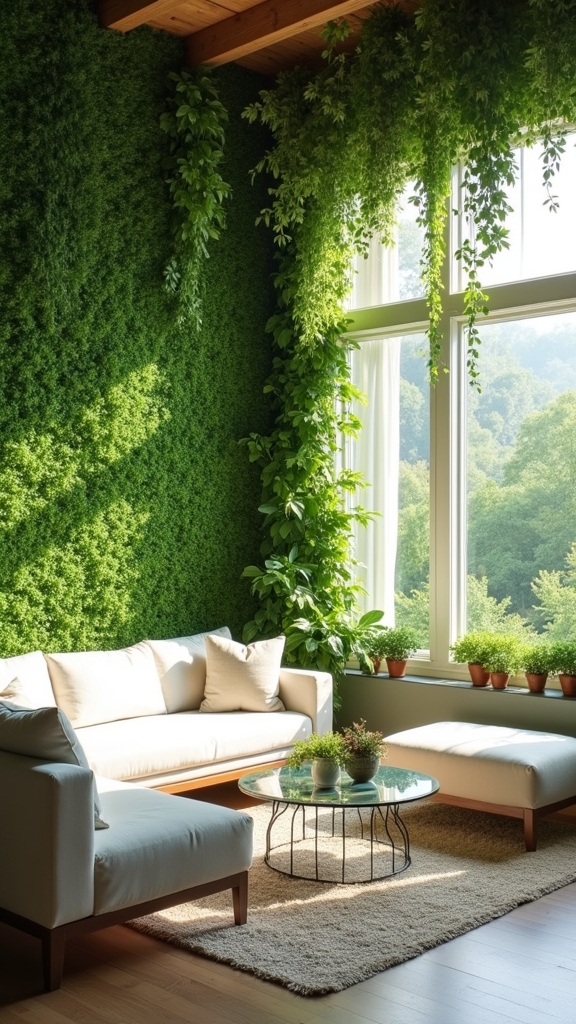
Effortlessly cultivating a sense of openness, light green walls serve as a luminous backdrop that maximizes spatial perception in contemporary living rooms. This chromatic choice infuses the space with a fresh, airy atmosphere, amplifying both natural and artificial light to visually expand the room.
Pairing green walls with light, airy furnishings—such as cream or white upholstered sofas—reinforces a tranquil, inviting ambiance. Blonde wood elements in furniture and accessories introduce subtle warmth, maintaining a harmonious balance without detracting from the freshness of the light green walls.
For added visual intrigue, black and white accents punctuate the palette, delivering crisp contrast and modern sophistication. Strategically positioned plants near green walls accentuate the biophilic design, deepening the connection to nature and enhancing the calming effect of the overall composition.
Creating a Serene Oasis With Pastel Greens
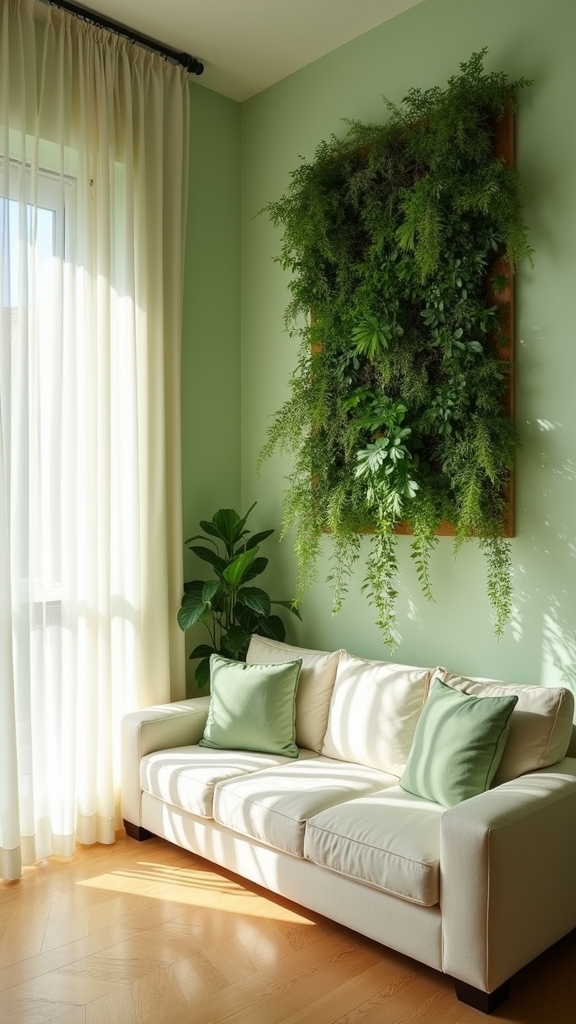
Layering soft green tones, such as mint and sage, establishes a nuanced chromatic foundation that enhances spatial tranquility.
Accenting with pastel-hued decor—think blush ceramics or muted textiles—introduces subtle contrast while maintaining visual cohesion.
This approach leverages tonal harmony and material interplay to curate a serene, design-forward oasis.
Layering Soft Green Tones
When pastel greens such as mint and sage are thoughtfully layered within a living room, they establish a tranquil chromatic foundation that is both soothing and visually expansive.
These soft green tones harness natural light, amplifying the room’s brightness and fostering an airy, restorative ambiance.
Integrating light, tactile materials—like rattan and raw wood—reinforces the biophilic design philosophy, drawing a seamless connection to nature.
The interplay of muted greens with subtle creams or beiges yields a cohesive, serene palette that remains contemporary and timeless.
- Layer mint and sage wall paints or textiles for a nuanced, harmonious effect.
- Pair soft green tones with rattan accents and pale woods for organic warmth.
- Incorporate leafy houseplants to amplify biophilic design and purify air.
- Use neutral-toned cushions and throws to maintain chromatic balance.
Accenting With Pastel Decor
Pastel green accents—such as cushions, vases, and delicate artwork—introduce a refined serenity to contemporary living rooms, functioning as both visual anchors and mood enhancers.
Employing pastel greens as an accent color against a neutral backdrop—think crisp white or soft beige walls—highlights the hue’s calming qualities while maintaining spatial luminosity. Mint and soft sage, in particular, foster a tranquil, biophilic ambiance, echoing the natural world.
When integrated with complementary pastel tones like peach or blush pink, the result is a harmonious, on-trend palette that softens the overall aesthetic.
Pairing pastel greens with organic textures—light woods, rattan, and linen—further amplifies a sense of cohesion and warmth.
This nuanced approach transforms the living area into a serene oasis that feels both fresh and inviting.
Dramatic Dark Green Feature Walls
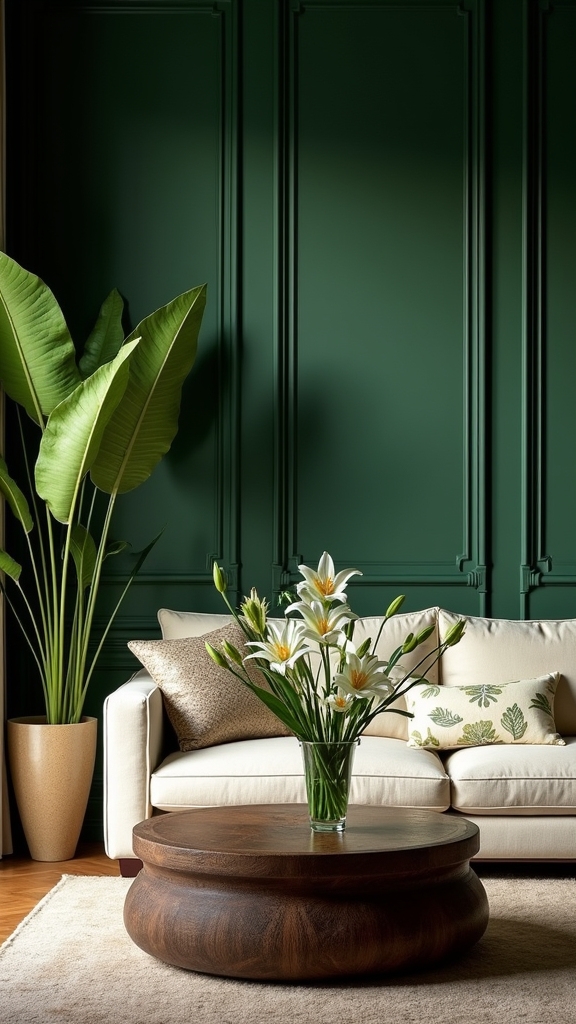
A dark green feature wall serves as a dramatic anchor in contemporary living room design, introducing depth and refined sophistication while fostering a tranquil atmosphere.
This bold hue, particularly in shades like Ottilie by Craig & Rose, offers a striking canvas that enhances the visual weight of the space. The interplay of dark green with light-toned furnishings or natural wood surfaces results in a compelling contrast, while metallic accents—such as gold or brass—infuse understated glamour.
Dark green walls create striking contrast with light furnishings and wood, while touches of gold or brass add refined, understated glamour.
This approach thrives in rooms abundant with natural light, ensuring the deep tone remains inviting rather than overwhelming. When orchestrated with careful balance, the dark green feature wall uplifts modern interiors, blending boldness with harmony.
- Select a rich, matte dark green paint.
- Pair with neutral or wood furniture.
- Integrate brass or gold accents.
- Maximize natural light exposure.
For a cohesive look, consider room size when choosing a dark green shade, as it can impact the atmosphere and perception of space.
Integrating Green Walls in Work-from-Home Corners
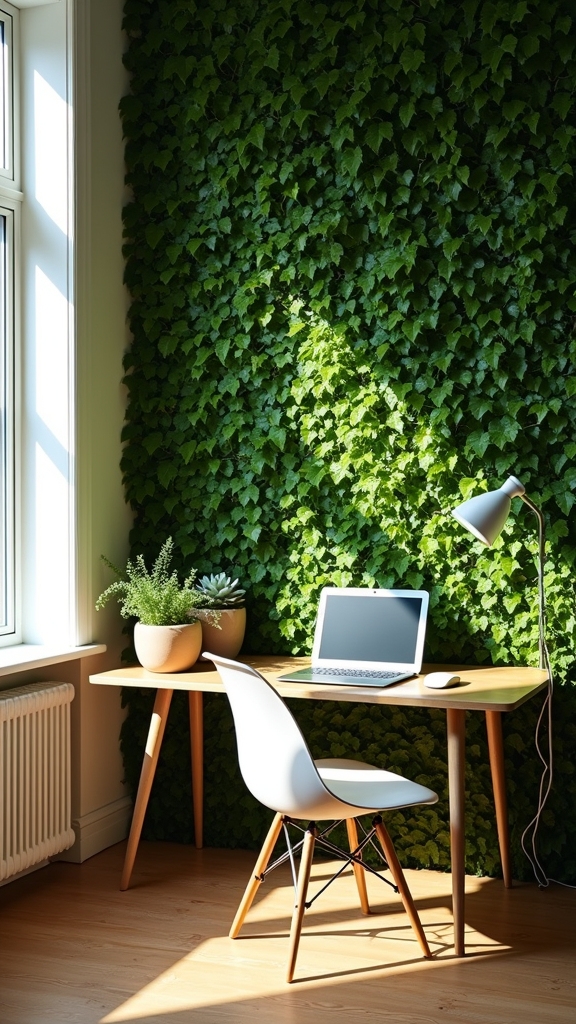
By incorporating green walls into work-from-home corners, designers craft a visually serene yet dynamic backdrop that enhances both productivity and spatial ambiance. The integration of botanicals into these dedicated zones not only improves air quality but also infuses the workspace with biophilic energy, reducing stress and promoting well-being. Selecting lighter green hues—such as sage or mint—maintains an open, airy atmosphere, counteracting any sense of enclosure. Ideal placement near natural light amplifies plant vitality and the overall vibrancy of the green wall installation. For added tactile and visual interest, textured components like wall panelling or botanical wallpaper are utilized, fostering an inspiring environment tailored for creative and focused work. Incorporating ambient fragrances such as bergamot or frankincense into the workspace can further enhance coziness and relaxation, complementing the natural elements of the green wall.
Retro-Inspired Green Wall Schemes
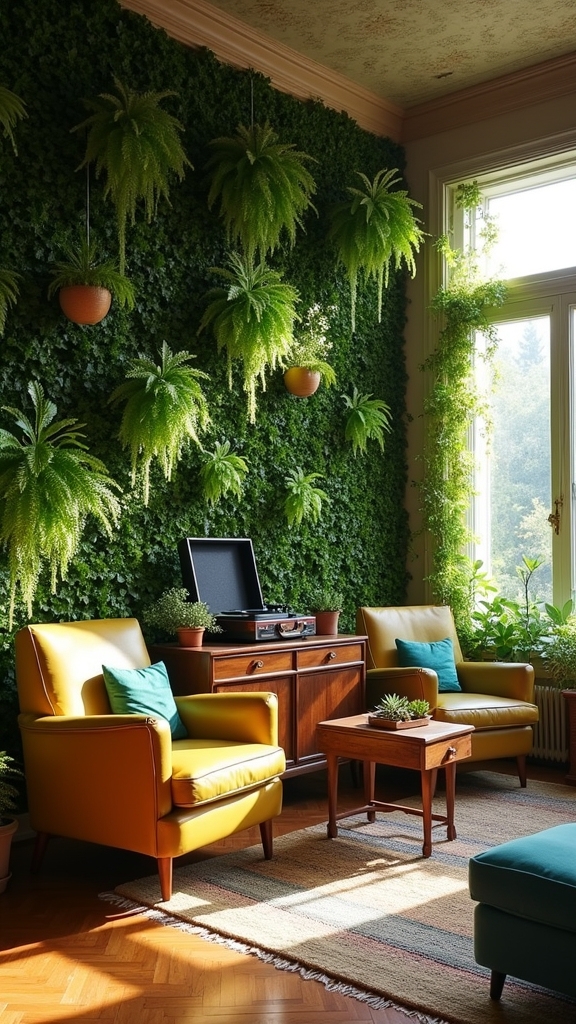
While drawing inspiration from mid-century interiors, retro-inspired green wall schemes harness saturated hues—such as forest green and olive—strategically juxtaposed with warm terracotta and reddish brown accents to evoke a sense of nostalgia.
Retro-inspired green walls blend deep forest and olive tones with terracotta and brown, creating nostalgic warmth reminiscent of classic mid-century interiors.
This aesthetic relies on geometric patterns and playful prints to infuse walls with a vibrant 70s dynamic, allowing the green walls to serve as a dramatic backdrop.
Heavy drapery and vintage furnishings accentuate architectural features, while a blend of tactile materials—like velvet cushions and woven rugs—cultivates a cozy retro ambiance.
Carefully curated retro accessories, including eclectic decor and vintage artwork, unify the scheme for a cohesive visual narrative.
- Choose bold green hues with terracotta and brown highlights.
- Apply geometric patterns for a vintage 70s flair.
- Layer textures—velvet, woven textiles, and heavy curtains.
- Incorporate retro-inspired decor and vintage art.
Combining Green Walls With Monochrome Accents
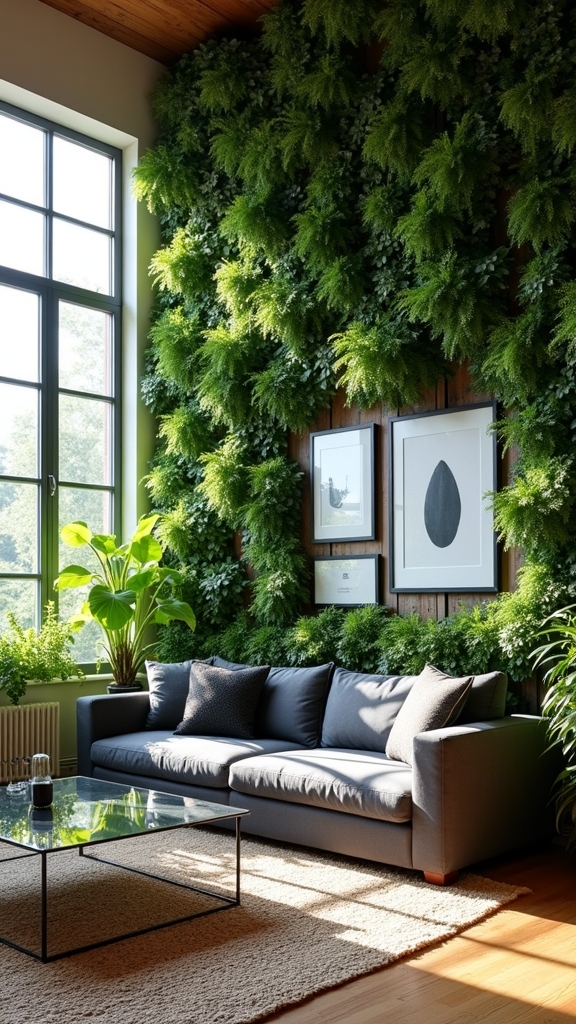
Pairing green walls with black accents introduces a graphic edge that sharpens spatial definition, while white elements amplify luminosity and freshness. This interplay of deep and light monochrome tones strategically balances the boldness of green, ensuring visual harmony within a contemporary context. Thoughtful use of contrasting finishes further enhances the dynamic between color and form. Incorporating natural elements and cozy spaces can soften the monochrome palette, creating a more inviting and balanced environment.
Balancing Green With Black
When green walls serve as the central design element in a living room, introducing monochrome black and white accents creates a sophisticated interplay of contrast and cohesion.
Black accents, such as matte-finish furniture or minimalist lighting fixtures, anchor the space, allowing the lushness of green walls to command attention without visual clutter. This high-contrast harmony enhances the room’s aesthetic, ensuring the green remains vibrant yet balanced.
Layering different textures—velvet cushions, lacquered surfaces, or woven textiles—adds tactile interest while adhering to a restrained palette. The versatility of green enables experimentation with tonal variations of black, from deep charcoal to sleek jet.
- Opt for streamlined black accent chairs or coffee tables.
- Integrate monochrome patterned textiles for depth.
- Use sculptural black lighting fixtures.
- Pair with green botanical artwork for visual continuity.
Enhancing White Accents
A thoughtful application of white accents amid green walls enhances the visual clarity and luminosity of a living room, establishing an open, contemporary atmosphere. The interplay between lush green walls and crisp white accents—whether in furniture, textiles, or decor—creates a harmonious palette that feels both fresh and inviting. White accents reflect natural light, amplifying the perceived spaciousness and allowing the depth of the green walls to stand out. When paired with monochrome black elements, the scheme gains a sophisticated edge, while varied textures and finishes inject visual interest and prevent monotony. This approach highlights the biophilic qualities of green walls, ensuring a serene yet trend-forward aesthetic for modern interiors.
| Element | Effect on Space |
|---|---|
| White Sofa | Brightens & opens the room |
| Glossy White Decor | Reflects light, adds sheen |
| Black Picture Frames | Grounds the color palette |
| Textured White Throws | Adds dimensionality |
Using Green Walls as a Backdrop for Gallery Displays
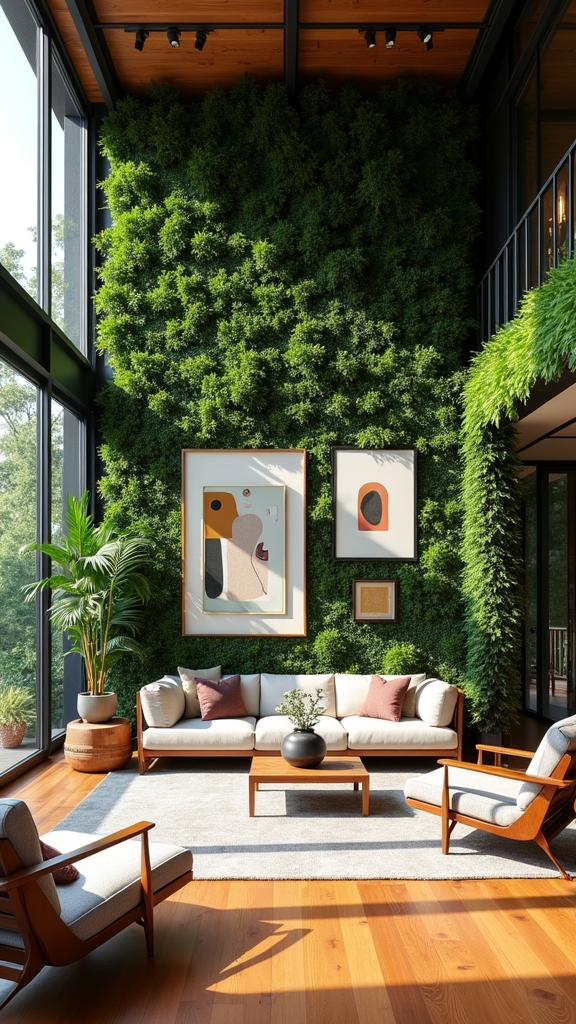
Emerald backdrops have emerged as a sophisticated choice for curating gallery displays in contemporary living rooms. Green walls serve as a calming, organic canvas that accentuates the vibrancy and detail of displayed artwork. The selection of a green hue that harmonizes with the artwork’s palette contributes to visual unity and an enhanced design experience. Employing matte finishes or textured wallpapers enhances depth, allowing framed pieces to command attention without overwhelming the aesthetic. Mixing textures creates a unique living room tapestry that invites tactile experiences. Strategic placement—varying the heights of artwork—introduces movement, inviting the eye to explore the entire gallery. When paired with ample natural light, green walls amplify both color and atmosphere, transforming the display into a focal point.
- Select green wall shades that complement the artwork.
- Use matte or textured finishes for added depth.
- Vary artwork heights for dynamic visual flow.
- Maximize natural light to enhance vibrancy.
Enhancing Green Walls With Indoor Plant Shelves
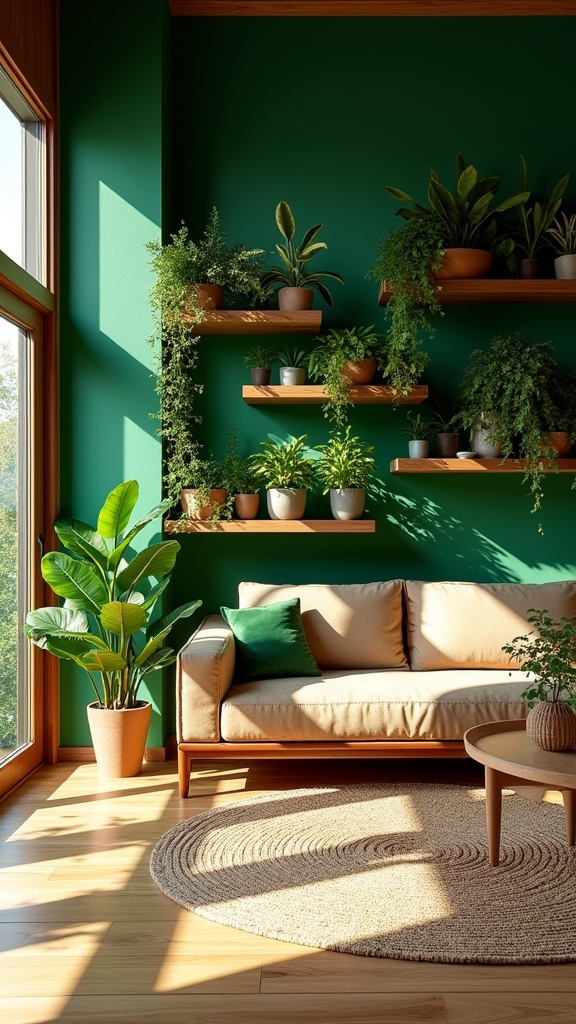
Indoor plant shelves introduce opportunities for sophisticated layering, blending cascading foliage with sculptural upright varieties to achieve dynamic visual interest against green walls.
This approach maximizes vertical greenery, transforming flat surfaces into multidimensional living installations that amplify biophilic design principles.
Thoughtful curation of plant species and shelf materials guarantees a cohesive, on-trend aesthetic while optimizing both space and air quality.
Layering Foliage and Decor
When thoughtfully integrated, plant shelves introduce both structure and versatility to green walls, amplifying their biophilic impact within the living room.
Indoor plant shelves serve as modular frameworks, allowing curated arrangements of foliage that play with scale, color, and texture. This layered approach not only enriches the visual narrative but also supports a dynamic, ever-evolving interior environment.
The interplay of shelf placement and botanical variety creates a sophisticated, organic tapestry that resonates with contemporary design trends.
- Vary Plant Heights: Combine trailing vines and upright greenery on indoor plant shelves to generate dimension and visual intrigue.
- Enhance Light Exposure: Position shelves near windows or light sources for ideal plant health and vibrancy.
- Mix Planter Styles: Select containers in coordinating hues and finishes to unify green walls with the surrounding décor.
- Refresh Regularly: Rotate or update plant selections to maintain freshness and seasonal relevance.
Maximizing Vertical Greenery
Building upon the layered interplay of foliage and decor, maximizing vertical greenery with indoor plant shelves refines the living room’s spatial dynamics while elevating its biophilic narrative. Strategically placed shelves on green walls enable curated plant displays, transforming vertical surfaces into living art. By selecting resilient species such as pothos, ferns, or succulents, homeowners achieve a lush yet manageable vertical garden. Material selection—wood for warmth, metal for modernity—ensures the shelves harmonize with green wall textures. Positioning these indoor plant shelves near natural light optimizes growth and visual vibrancy. Varying shelf heights foster depth and movement, enhancing the room’s organic rhythm.
| Plant Choice | Shelf Material | Placement Tips |
|---|---|---|
| Pothos | Wood | Near windows |
| Ferns | Metal | Varying heights |
| Succulents | Wood/Metal | Well-lit corners |
| Mixed Greens | Composite | Layer for texture |
Double-Drenching: Green Walls and Ceilings
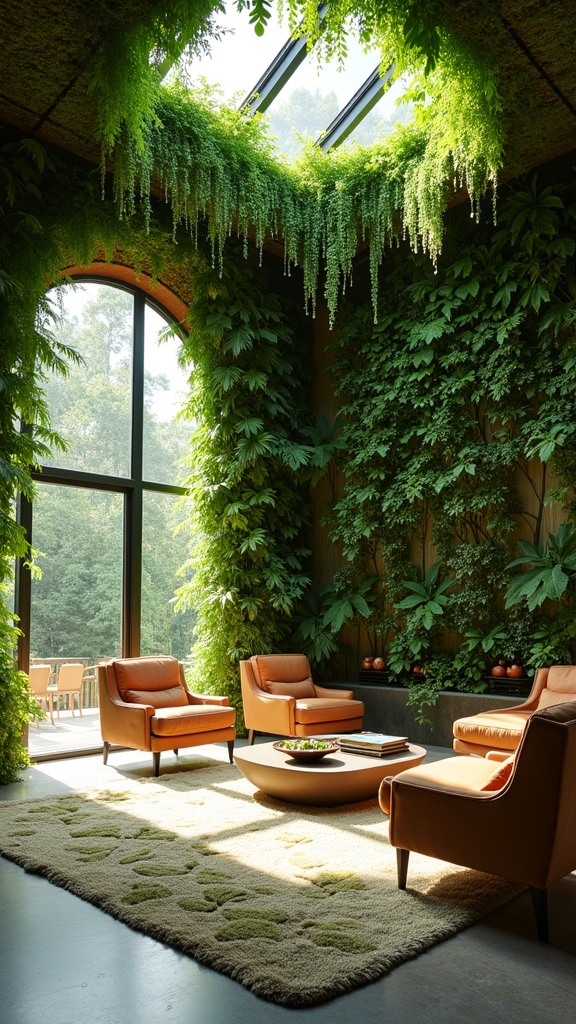
Immersion defines the double-drenching technique, where both walls and ceilings are enveloped in green hues to increase tranquility and a biophilic sensibility within the living room.
This trend-forward approach leverages green walls paired with color-drenched ceilings, producing an enveloping, serene backdrop. Designers often select shades from pale mint to deep forest green to optimize cohesion and visual fluidity.
The technique visually raises ceiling height, amplifies spatial openness, and enhances relaxation. Contrasting accents, such as white trim or natural wood, temper the intensity, preventing claustrophobia while emphasizing sophistication.
Ideal results are achieved in luminous spaces, where natural light reveals tonal nuances.
- Choose complementary green shades for walls and ceilings.
- Integrate light furnishings for balance.
- Employ natural wood or white accents.
- Maximize daylight to enhance color depth.
Tropical Vibes With Leafy Green Murals
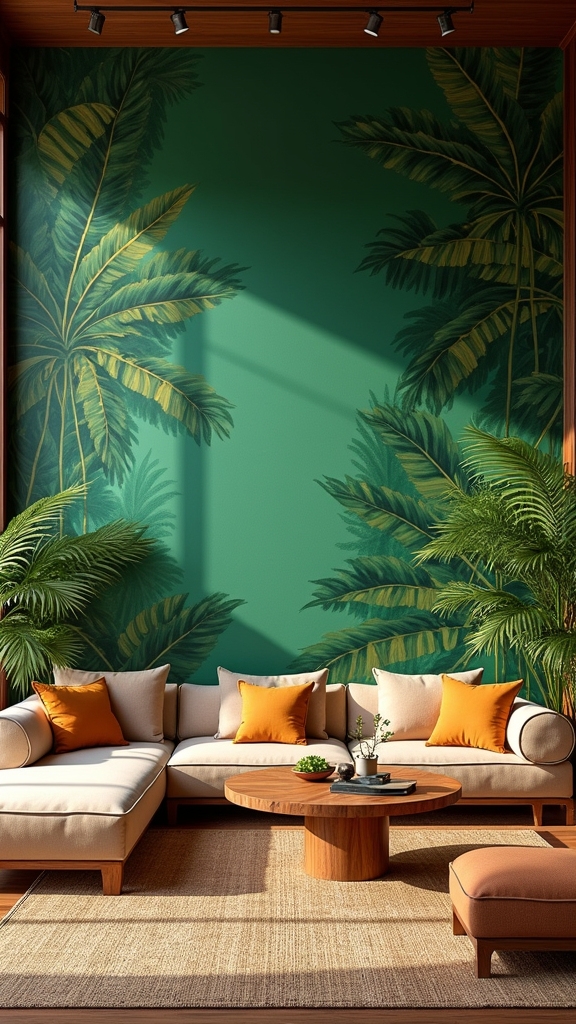
A single, expansive leafy green mural can instantly transform a living room into a lush, tropical sanctuary, serving as a dynamic focal point that fuses biophilic design with contemporary aesthetics.
Leafy green murals featuring oversized philodendron, monstera, or palm motifs evoke tropical vibes, enveloping the space in a serene, vacation-like ambiance.
Oversized leafy murals bring lush, tropical energy to your living room, creating a serene escape reminiscent of a tranquil vacation retreat.
When paired with organic textures—such as rattan furnishings or natural wood finishes—the mural’s verdant hues harmonize with tactile elements, reinforcing a seamless indoor-outdoor connection.
Strategic placement of living plants alongside these murals enhances depth and dimension, while simultaneously improving air quality.
Light-toned furniture and minimalist decor allow the mural’s saturated greens to visually anchor the room, maximizing impact and ensuring the artwork remains the centerpiece of this nature-inspired, trend-forward living environment.
Frequently Asked Questions
What Color Goes With Green Walls in a Living Room?
When selecting complementary colors for green walls in a living room, designers utilize color psychology to pair mid-greens with monochrome accents, lighter greens with warm hues, or deep greens with metallic finishes for a balanced, aesthetically sophisticated palette.
How Do You Make an Earthy Living Room?
To create an earthy living room, designers combine earthy textures and natural materials such as wood, rattan, and stone. Layered textiles, botanical motifs, and an organic color palette further enhance biophilic design, fostering a tranquil, sophisticated ambiance.
Is Green a Good Colour for Living Room?
The question of green’s suitability for living rooms centers on green color psychology and living room ambiance. Designers note green’s biophilic qualities foster tranquility, while its chromatic versatility aligns with contemporary aesthetics, supporting stress reduction and mood enhancement through environmental design.
How to Make Green Walls Look Good?
To raise green walls, one should consider curated plant selection for biophilic synergy and incorporate wall textures like fluted paneling or botanical wallpaper. Harmonizing with neutral furnishings and layered green accents creates a contemporary, visually dynamic living space.
Conclusion
Bringing green walls into the living room seamlessly fuses biophilic design with contemporary aesthetics. From lush vertical gardens to botanical wallpapers and verdant accent walls, these nature-inspired solutions offer both visual intrigue and wellness benefits. By integrating organic textures, layered plant displays, and on-trend hues, homeowners can craft immersive spaces that rejuvenate the senses. As living walls continue to trend, their technical versatility guarantees that every interior can embrace a bespoke, eco-chic ambiance rooted in modern design principles.
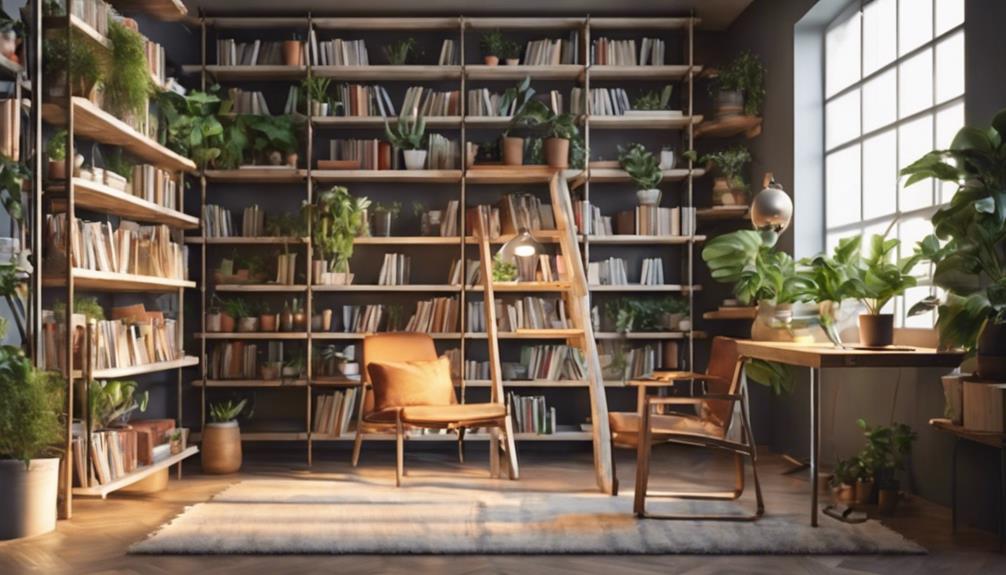
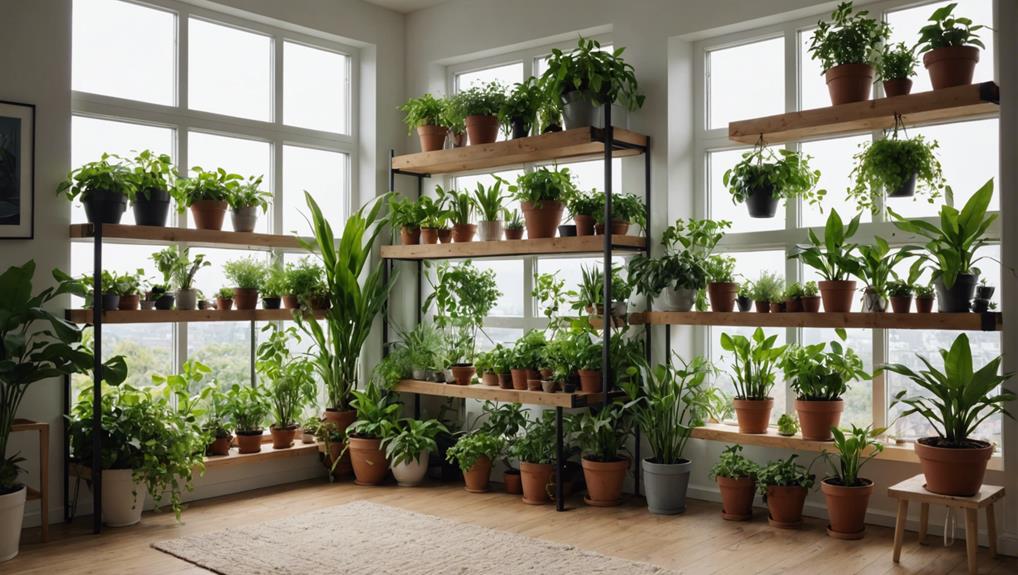
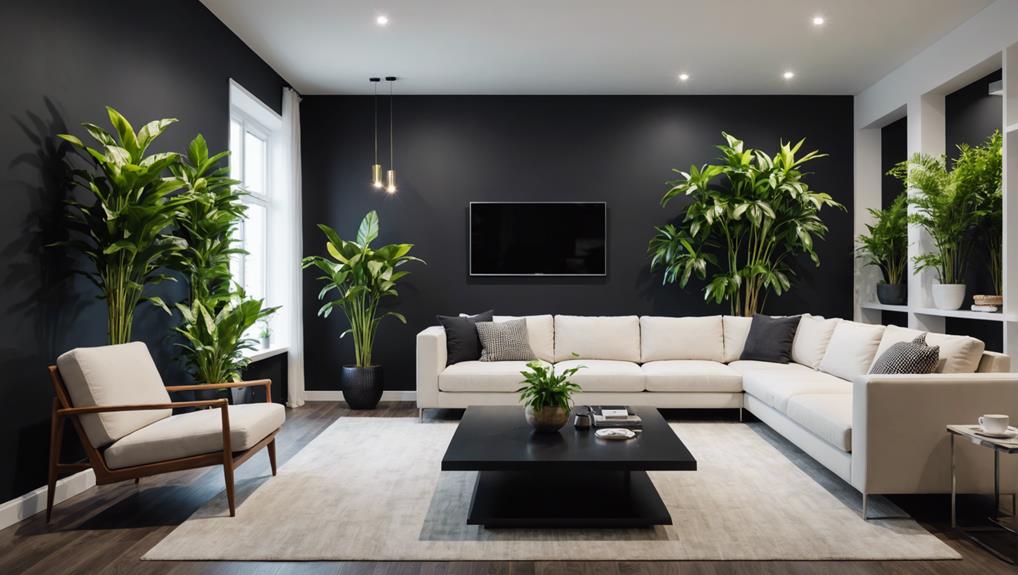
Leave a Reply